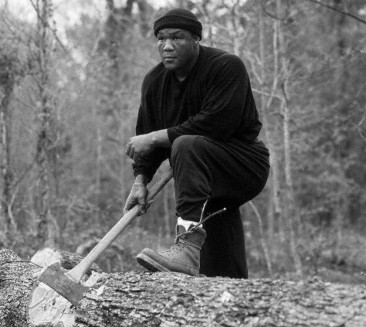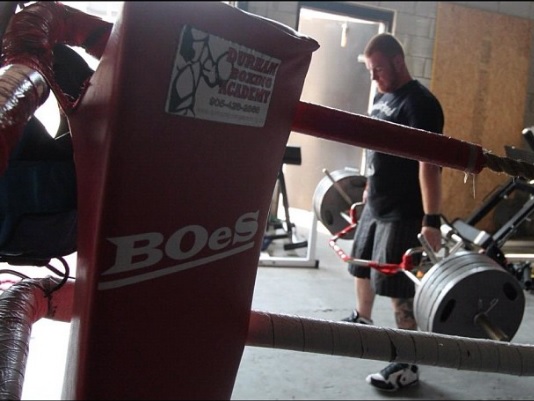Once you’ve built a solid base with our beginner weight training program, you’re ready to focus on building some sport-specific qualities that are known to increase punching power.
Today’s post is all about how to increase punching power in the weight room by focusing on two underappreciated forms of strength: grip and deceleration. Read on to learn all you need to know to go from slap-fighter to Hands-of-Stone!
Building “Hands of Stone” with Grip Training
Would you rather hit your opponent with a bag of rocks or a boulder?
Increasing grip strength lets you make a tighter fist, which always hit harder than an open hand.
A tight fist transmits more of the force that your legs, hips, and torso put into the punch. As coach Brandon Krause puts it, “if [the fist] is truly the last link of the chain, wouldn’t you want that striking surface to be as strong as possible?”
Are Gennady Golovkin’s monstrous power and crushing grip related?
People asking how to increase punching power usually aren’t blown away by this tip, and that’s okay; it’s nothing revolutionary, but it is effective.
And that’s why it’s so surprising to see how many fighters still refuse to clench their fists hard on impact.
Have you ever spotted your gym mates punching with open hands during a shadowboxing workout? Unless they’re working some serious hand-control games, they’re guilty of this bad habit.
Sometimes we punch with loose grip because we’re focusing on speed or throwing a flurry. More often, it’s because we’re lazy; clenching with a hand-wrap and glove on takes energy we’re not willing to spend.
If you’re in the latter camp, implementing some simple grip training exercises will give you the hand strength and endurance to punch harder for longer than ever before.
Of course, grip training also prevents injury. This is something Ross Enamait stresses in his classic book The Boxer’s Guide to Performance Enhancement, in which he admits he wished he started training his grip earlier to prevent the injuries that derailed his boxing career.
How to Increase Punching Power with Hand Exercises
Forget the days of “maxing out” on department store hand grippers and forearm curls.
There are some great resources out there on grip training. These are a couple of my favourites that give you the best of low-tech basics and modern sports science:
1. Training the Hands by Ross Enamait
Ross Enamait is a master of low-tech, high-effect training for combat athletes, as this post shows. Here’s one example of a dirt-cheap piece of hand-training equipment:

I use the “Rice Grip” exercise pictured below every training session, either as a warm-up before bag work or a grip-intensive finisher for a shadowboxing session. I prefer to work this drill in “rounds,” but you can also set a rep goal and work at your pace. After a few weeks of 3×1-minute rounds, I felt the difference on my punches, and it’s also reduced the stiffness I feel after typing.
In addition to the grabbing-and-twisting motion Ross describes, I like to open my hand against the resistance of the rice to balance things out. To do this, spear your hand into the bucket with your fingertips and thumb together, open, and repeat.
Ross also recommends old-school wood chopping as a two-for-one grip and rotational power training exercise. Many gyms are now equipped with sledgehammers and tires for a super-charged indoor alternative. I really enjoy both, if only because it makes me feel as cool as George Foreman.

If you have access to a sledgehammer and tire or ax and tree, try it out. WARNING: BE CAREFUL! Warrior Punch isn’t responsible for your hacked limbs and hammered toes.I recommend 2-3 2-minute rounds to start. Use it as a finisher to a weight training session or after putting in your roadwork.
I also use Ross’s sample hand circuit in place of my usual push-ups and pull-ups when I want some extra grip training.
Sample Hand Circuit:
- Towel pull-ups
- Knuckle push-ups
- Fingertip push-ups
- Wrist roller (see article)
- Rice grip (each hand)
Perform one quality set, which Ross says should stop at around 80% of your maximum. To begin, perform 1-3 circuits, 2-4 per week.
Check out the full article for exercise descriptions and more on how to increase punching power with common household items.
2. Old School Grip Training by Chad Waterbury
Chad Waterbury puts together excellent strength and conditioning materials for combat athletes. Though this article is written for an audience interested in powerlifting performance and aesthetics, the combat sports carryover is huge.
Waterbury takes a smarter approach to grip training, applying Vladimir Zatsiorsky’s holy trinity of strength building: the Maximal Effort Method, Dynamic Effort Method, and Repeated Effort Method.
Some recommended exercises include:
- Finger band extensions
- Plate pinch extensions
- One-hand upright dumbbell lifts
- Fat grip barbell work
- Heavy-duty grippers (Captain of Crush are the gold standard, ranging from the 100-pound Trainer to the 365-pound Level 4)
- Alligator smash
Full exercise descriptions and demonstrations are included in the article. Experiment with some of these variations and see what works for you.
Building Better Brakes for High-Power Performance
When Wil Fleming and Coach Dos were asked to put together a “movement menu” on episode 3 of the Performance Podcast, they both agreed that the lunge deserved a top spot. I was used to hearing the squat, deadlift, bench, row, and overhead press get all the glory when it comes to power development, so this came as quite the shock.
To justify their pick, they highlighted how the forward lunge develops deceleration strength. This is because the negative movement has to be decelerated and turned into a concentric contraction in order to return back to the starting position.
Put simply, lunges build our brakes. Better brakes mean faster, more efficient transitions between high-power athletic movements, so you can counter faster off a slip or punch quicker in combination with the same hand.
Better brakes mean better power. The body will unlock its full potential only when it can handle it; in this case, you accelerate only to the point your body is capable of comfortably decelerating. Therefore, building your brakes unlocks your true punching power.
Be sure to incorporate lunges into your weight training program. Mix in different variations to train your deceleration strength in all planes of motion.
You should also be building brakes in terms of your upper-body pulling muscles. Many people overemphasize the bench press while neglecting their rows, pull-ups, and chins, and this push/pull imbalance hinders power output. For healthy shoulders and better punching power, increase the volume of your pulling to 2-3 times that of your pushing exercises.
Wrapping Up
Failing to implement these exercises to improve your grip and deceleration strength could what’s be stopping you from pushing past your current power-punching plateau. But don’t lose sight of other factors.
As you probably already know, if you want to learn how to increase punching power, the first step is to review your punching mechanics.
Study the basics and strive to master specific punches one-by-one. Check our top-12 power tips while you’re at it.
As you focus on skill development, begin strength training. Review our weight training program and start working with whatever tools you like. There’s a lot of cult behaviour out there when it comes to different strength training systems, but it’s stupid to limit yourself to any one thing – barbells, bands, kettle bells, sand bags, body weight, club-bells, steel maces, and odd objects are all useful modalities. Find what works for you.
Once you have your general strength and skill training in order, you can experiment with some of the different training protocols we covered here. Find what exercises and programming style works for you. I prefer tacking grip training onto every workout in small doses, while others like to schedule dedicated mini sessions.
Give these exercises a shot and share questions and results in the comments section.
Happy training and stay healthy!
Special thanks to Brock Arthur, professional fighter and owner of Durham Boxing Academy, pictured in the Feature Image.
